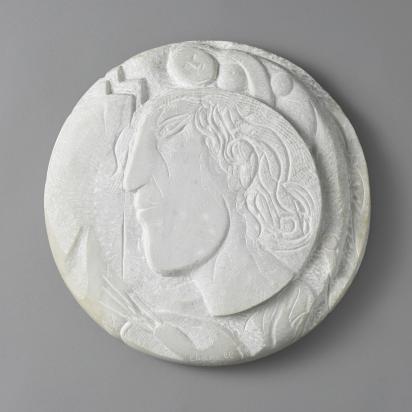In this low-relief marble sculpture, Chagall as sculptor portrays himself as a painter viewed from the side, in the center of a sun-like circular shape that looks like a medallion. The artist’s face stands out from the rest of the composition, featuring repeating circles, thanks to a play on volumes achieved when the stone was carved away.
It was no surprise that Chagall, who had been sculpting since the early 1950s, created a sculpted Self-portrait in 1952 followed by a second one, more than a decade later, in 1968-69. The self-portrait played a dominant role in his graphic and painted works, from the very beginning of his career. One of his most famous is Self-portrait with Seven Fingers [Autoportrait aux sept doigts] (1912 - 1913). The artist portrays himself holding a palette in one hand, in front of the painting To Russia, Donkeys, and Others [À la Russie, aux ânes et aux autres] (1911) in mise en abyme. Marc Chagall distances himself from mimesis, from an accurate depiction, preferring to draw or engrave, as he did in this sculpture, distinguishing features which have become recurring iconographic elements with a decorative function: a long nose, wavy hair, oblong eyes.
The multitude of self-portraits and the use of his own image, here in a younger version, reveal a perpetual questioning of his identity and status as a painter. The painting’s features, such as the easel, the hand holding the palette and brushes, and a female figure—probably his muse or model—surround his profile and illustrate his attachment to painting1. His use of other techniques, such as sculpture, ceramics, or stained glass beginning in the 1950s and then the 1960s, allowed him to enrich his pictorial work and rise above the “contemporary painting crisis” thanks to this alternation and dialogue between media2.
Such a particular circular shape, the subject in profile, and his highly stylized curls—formed by clean incisions in the marble—echo antique coins with imperial effigies, like Italian tondi, and more broadly place the work in the tradition of the medallion portrait3. Chagall’s decision to use this material, a stone in use since Antiquity, gives a noble and timeless aspect to the piece. Yes, the artist is depicting his own image, but, more importantly, it is a consequential tribute to design and painting in that it celebrates the artist as a figure.
